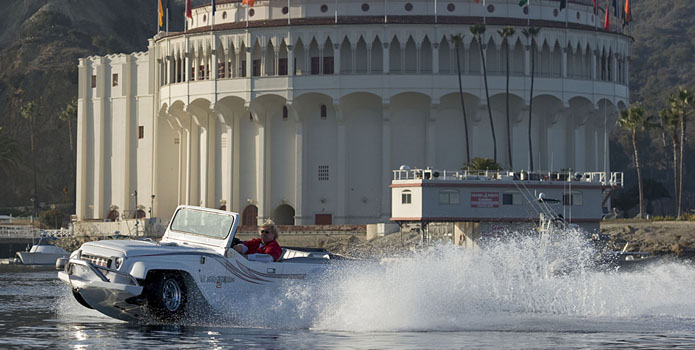The WaterCar’s Successful Pacific Ocean Crossing
What started out as a whim grew into an all-consuming passion after Southern California resident Dave March caught a glimpse of an amphibious vehicle on a local TV show in 1999.

“It looked pretty cool, driving a car on the water,” recalled March, who bought a 1961 Amphicar a few months later and spent a year restoring it with his then 10-year-old son. “We were pretty excited to try it out when we were done, but when we got it in the water and pressed on the accelerator pedal, it was putt-putt, not much happened.”
Fast-forward nearly 15 years and on one of Southern California’s balmy winter days, March drove out of his Fountain Valley factory in his latest Panther WaterCar creation making an 8-mile journey to Newport Beach. At water’s edge, March didn’t hesitate, he drove in at speed, pulled the lever on his patented transfer case to convert wheel power to water jet pump thrust on-the-fly, and off he went to Avalon Harbor on Catalina Island some 30 miles away across the blue Pacific Ocean.
“I’ve been thinking about making this trip ever since I started the WaterCar project,” March said. “Every time I looked across the channel to Catalina on a clear day, I kept saying to myself, it doesn’t look that far. However, once you get a mile or two out from the mainland your perspective kind of changes. After all, I’m driving a boat that’s barely 16 feet long and it’s a big ocean out there.”
 |
 |
The weather gods smiled upon March on the mild January day as water conditions were ideal for the attempt with only a light swell, more lake-like than an ocean.
“It was really a pretty pleasant crossing,” said March, after he made a celebratory sweep past the iconic Avalon casino structure marking the entrance to the harbor. “It was really cool about halfway over. A pod of curious dolphins picked me up and chased alongside the WaterCar for a couple of minutes. I was doing about 30 mph and they didn’t seem to have any problem keeping up.”
In less than 90 minutes, March had driven out of his factory, down Orange County streets, into the water and arrived at Avalon Harbor to achieve a long sought-after goal. “I think we proved a lot today,” he commented. “Anybody can build a car that floats, but getting it so it will plane and run with stability, efficiency and reliability is a whole different matter.”
March said that just recently the WaterCar has gone into full production.
“We have orders and are building product,” he added. “We’re getting a lot of interest from the United Arab Emirates, and the Prince of Dubai has ordered six. We’ve also taken a couple of deposits from two prominent business executives in Silicon Valley. We’ve even had several NASCAR drivers express interest.”
After trying a number of different engine and jet pump combinations, today’s WaterCar has seemingly found its ideal match. The standard engine is a 250-hp V-6 Honda V-Tech, which is the same powerplant that Honda uses for its four-stroke 250-hp outboard.
The jet pump is an axial flow Panther jet drive system, which March now owns the tooling, and was quite popular in the 1970s and ’80s. The transfer case, which converts engine power from the wheels to the jet pump and back, is something March developed years ago and is one of 27 patents he holds for the WaterCar.
The Panther model has an on-water top speed of 45 mph (and yes, it will pull a wakeboarder or waterskier) and can reach 85 mph on the highway. And it is street legal and also able to be registered as a boat.
If you’d like one for yourself, the retail price tag is around $135,000.
“I know we’re still in the very early stages,” March said, “but we want the WaterCar to be the Henry Ford of amphibious vehicles.”

